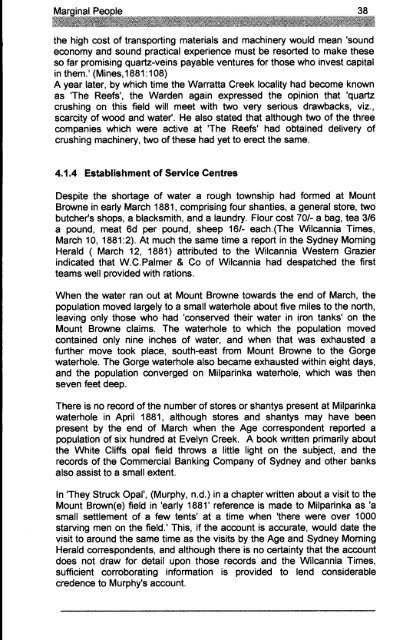Adec Preview Generated PDF File - The Sydney eScholarship ...
Adec Preview Generated PDF File - The Sydney eScholarship ...
Adec Preview Generated PDF File - The Sydney eScholarship ...
You also want an ePaper? Increase the reach of your titles
YUMPU automatically turns print PDFs into web optimized ePapers that Google loves.
the high cost of transporting materials and machinery would mean 'sound<br />
economy and sound practical experience must be resorted to make these<br />
so far promising quartz-veins payable ventures for those who invest capital<br />
in them.' (Mines,1881:108)<br />
A year later, by which time the Warratta Creek locality had become known<br />
as '<strong>The</strong> Reefs', the Warden again expressed the opinion that 'quartz<br />
crushing on this field will meet with two very serious drawbacks, viz.,<br />
scarcity of wood and water'. He also stated that although two of the three<br />
companies which were active at '<strong>The</strong> Reefs' had obtained delivery of<br />
crushing machinery, two of these had yet to erect the same.<br />
4.1.4 Establishment of Service Centres<br />
Despite the shortage of water a rough township had formed at Mount<br />
Browne in early March 1881, comprising four shanties, a general store, two<br />
butcher's shops, a blacksmith, and a laundry. Flour cost 70/- a bag, tea 3/6<br />
a pound, meat 6d per pound, sheep 16/- each.(<strong>The</strong> Wilcannia Times,<br />
March 10, 1881:2). At much the same time a report in the <strong>Sydney</strong> Morning<br />
Herald ( March 12, 1881) attributed to the Wilcannia Western Grazier<br />
indicated that W.C.Palmer & Co of Wilcannia had despatched the first<br />
teams well provided with rations.<br />
When the water ran out at Mount Browne towards the end of March, the<br />
population moved largely to a small waterhole about five miles to the north,<br />
leaving only those who had 'conserved their water in iron tanks' on the<br />
Mount Browne claims. <strong>The</strong> waterhole to which the population moved<br />
contained only nine inches of water, and when that was exhausted a<br />
further move took place, south-east from Mount Browne to the Gorge<br />
waterhole. <strong>The</strong> Gorge waterhole also became exhausted within eight days,<br />
and the population converged on Milparinka waterhole, which was then<br />
seven feet deep.<br />
<strong>The</strong>re is no record of the number of stores or shantys present at Milparinka<br />
waterhole in April 1881, although stores and shantys may have been<br />
present by the end of March when the Age correspondent reported a<br />
population of six hundred at Evelyn Creek. A book written primarily about<br />
the White Cliffs opal field throws a little light on the subject, and the<br />
records of the Commercial Banking Company of <strong>Sydney</strong> and other banks<br />
also assist to a small extent.<br />
In '<strong>The</strong>y Struck Opal" (Murphy, n.d.) in a chapter written about a visit to the<br />
Mount Brown(e) field in 'early 1881' reference is made to Milparinka as 'a<br />
small settlement of a few tents' at a time when 'there were over 1000<br />
starving men on the field.' This, if the account is accurate, would date the<br />
visit to around the same time as the visits by the Age and <strong>Sydney</strong> Morning<br />
Herald correspondents, and although there is no certainty that the account<br />
does not draw for detail upon those records and the Wilcannia Times,<br />
sufficient corroborating information is provided to lend considerable<br />
credence to Murphy's account.




